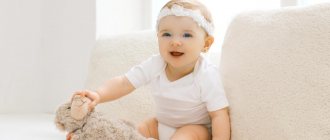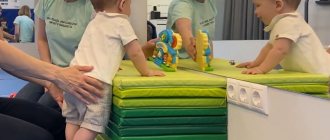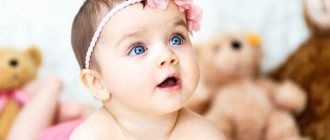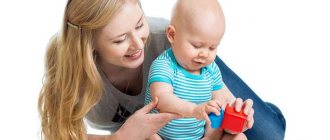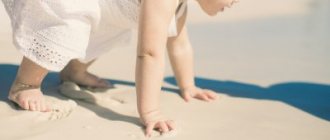During his first year of life, your wonderful baby has changed significantly. He has grown by 20–25 cm, his body weight has tripled, he has learned to drink from a cup on his own, put it on the table, use objects while playing, and perhaps he can walk. In addition to all this, your child probably understands the names of many objects, knows his own name and the names of the people around him, knows how to communicate using simple words, understands your “no”, carries out simple requests, memorized actions... So many achievements in such a short period ! Did you feel proud of your baby?
Physical activity
During the second year of life, the child's growth rate slows down significantly, this is the norm.
On average, a toddler is 1 year 3 months old. weighs 10.5 kg. The norm is considered to be all children slightly more or less than the average value, which is explained by many factors.
The toddler's growth rate also decreases slightly compared to the first year of his life.
Until the age of 4, the child’s growth increases evenly, by about 8 cm per year. The head circumference of a toddler up to 5 years old grows by 1 cm every year.
Chest circumference increases by about 1.5 cm every year, this trend is observed up to 10 years.
From 1 to 1 year 2 months. The child's first molars appear. First, the lower molars begin to erupt, and then it’s the turn of the upper molars.
Often, one-year-old toddlers sleep only once during the day.
Changes at the neuropsychic level
At the age of 1 year 3 months. the child becomes quite impulsive, he is inquisitive and emotional.
Height and weight of a child at 1 year 3 months, data from domestic pediatricians
| 1 year 3 months | Bottom line | Upper limit |
| Boys' weight, kg | 9,6 | 12,4 |
| Girls' weight, kg | 9,2 | 11,5 |
| Boys' height, cm | 75,9 | 83,0 |
| Girls' height, cm | 74,5 | 81,5 |
| Boys' head circumference, cm | 46,1 | 49,5 |
| Head circumference of girls, cm | 45,2 | 48,3 |
| Boys chest circumference, cm | 46,8 | 53,4 |
| Girls chest circumference, cm | 47,3 | 52,3 |
Physical activity
Walking skills are improving every day. Holding the little one by the hand, you can observe that he is trying to climb up and down the stairs on his own, and overcome some obstacles on his way.
At one year and three months, the child is already walking longer than a few months ago, his gait is much more confident, and his squatting skills are gradually being honed. The toddler tries to bend over and take a stable standing position.
Most children of this age can hold cutlery in their hands and use them for their intended purpose.
Child at 15 months. without much difficulty he performs simple movements: raising his arms and spreading them to the side, moving his fingers and making rotational movements with his hand. All these actions can occur either on the baby’s own initiative or at the request of the parents.
Physical development of the child:
- Makes attempts to get off the high chair.
- Crawls well; climbs several steps of stairs on all fours with equal ease, up and down.
- Walks up the stairs with support.
- Walks without support.
- Travels around living quarters: from crawling to walking, from walking back to crawling.
- Knows how to back away.
- Can climb on furniture.
- Fits well on a children's chair.
- He deftly throws the ball, kicks it (although he often misses), and rolls the ball.
- Uses various household items: toothbrush, cup, saucer, spoon, comb, etc.
- Can eat independently.
- He opens the doors of cabinets and bedside tables that are accessible to him, and takes out the objects found there.
- Helps an adult when getting dressed: he looks for the sleeve with his hand, and puts his foot into the shoe himself.
Understanding the world around us
The child’s development at the cognitive level is already noticeable; the child understands what joint play is. At one year and three months old, the toddler shows interest in children, namely their peers.
Kids not only look with interest at the funny pictures in the book, but also listen carefully to short poems and stories. In this way, the child communicates with his parents and enjoys turning the pages on his own.
Research activity of a toddler at 1 year 3 months. is gaining momentum, and understanding of cause-and-effect relationships is beginning. For example, if you build a pyramid of cubes high enough, it may fall.
The mental development of a child at one year and three months allows him to learn some rules of behavior and develop certain skills.
For example, by showing your toddler how to clean up his toys every day, you can develop the skill of cleaning up after yourself.
This also applies to simple daily hygiene procedures, as well as the process of dressing and undressing.
At one year and three months, the toddler can easily distinguish simple shapes of objects: a square, as well as a circle. Therefore, at the request of an adult, the child will quickly bring a ball or cube. Gradually, an understanding of the separation of objects both in size and color begins to emerge.
A toddler at one year and three months old easily completes the task of stringing rings onto the rod of a pyramid and building a tower out of cubes.
You can notice that the baby is already playing with toys: he rolls the car, sits him down, and then feeds the doll.
Every child, starting from the 13th month of life, tries to be like adults: “reads a book or newspaper, “talks on a mobile phone,” “cooks dinner.”
Mental development of the child:
- The baby loves playing with the ball.
- He is very interested in the contents of cabinets: he opens doors, pulls out drawers, throws the contents of cabinets outside and examines them for a long time.
- Uses dishes and toiletries.
- Likes to “talk” on the phone.
- Loves walks; when in a hurry to walk, it helps with dressing.
- Actively demonstrates his feelings: hugs and kisses his favorite toy, the person he loves.
- If he is forced to do something that he does not want, he gets angry and demonstrates independence with all his appearance.
- He knows close people not only by their faces, but also by their names; understands who they are talking about when they say their name.
- Correctly follows instructions such as “Take a spoon”, “Give me a toy”, “Throw a ball”, etc.
- Shows interest in objects that are more complex than toys, and is interested in their structure.
- Likes to take things out of boxes and put them back; closes the box with a lid.
- He enjoys playing with cubes: placing them one on top of the other.
- Can play with household items available to him: shoes, jewelry box, cups, saucepan, mom’s cosmetic set, hat, etc.
- “Talks” to the objects he plays with.
- Trying to draw.
What gymnastics are recommended at this age?
Children should not be forced to do exercises. Therefore, try to turn gymnastics into an exciting game that you can play both at home and while walking. You can do exercises to music to make it more fun.
Conduct classes daily or once every two days, 30-40 minutes after breakfast or immediately after a nap for 10-12 minutes.
Put on shorts, a T-shirt and socks for your baby. Perform exercises with an open window or in a ventilated room.
Before you start some fun gymnastics, prepare everything you need. You will need: funny toys, a hoop, a large ball, a stick or board, a box, a rug.
First independent steps
An adult stands on the floor, holding onto or leaning against an object, such as a table, sofa, chair. Lure the child with a bright toy, either bringing it closer or moving it away from the baby. Repeat 2-4 times.
Squat while holding a hoop
The baby holds with both hands the hoop, which is in the hands of an adult. At the command “Sit down!” the child squats without letting go of the hoop. Squat with him. Repeat 5-6 times.
Crawl through a hoop
An adult holds a hoop through which a toy is visible, attracting the baby’s attention. The child crawls through the hoop and straightens up. You can put the toy higher, for example, on a table. This will make the child reach for it. Repeat 4-6 times.
Crawl under an obstacle (stick or board)
Place an obstacle at a height of 30-50 cm. After crawling, invite the child to take out a toy placed on a stool 40-45 cm high. Repeat 3-4 times.
Flexion and extension of the torso
Place your child on your lap. Press your thighs against his shins. Flex and extend the baby's torso. Repeat 3-4 times.
Rolling the ball
Sit with your child on the floor opposite each other, legs wide apart. Roll the large ball in any given direction. Repeat 6-8 times.
Climbing on an object (box, sofa)
First, invite the baby to climb onto a box 10-15 cm high, and then onto a sofa 40 cm high. Repeat 2-3 times.
Squatting for a toy
Place 2-3 toys at different ends of the room. Encourage your child to squat to pick up toys. Repeat 2-3 times.
Throwing a ball
The child stands without support, holding a large ball with both hands. Let him throw the ball with both hands in any direction. Repeat 4-6 times.
Leg Raising
The child lies on his back on the mat. Hold the stick firmly above his feet at a height of 50–60 cm. The baby should raise his legs, trying to reach the stick with them. Repeat 3-4 times.
Walking
The baby stands without support. Encourage him to walk around the room at a distance of 5-8 meters, giving him the necessary support. Repeat 2-3 times.
How speech develops
Speech development occurs at a rapid pace, the child tries to clearly repeat words after adults, namely:
- Vocabulary increases significantly. The child enjoys learning new words and sounds, constantly repeating them throughout the day.
- An understanding of the meaning of many words appears, he knows the names of toys and objects, and, upon request, points with his finger at parts of the body, items of clothing, and food products that are voiced by an adult.
- The toddler can already carry out some simple instructions from his parents (bring a certain object, “play ok-okay”).
- Listening to fairy tales, rhymes, and songs is of great interest to the child.
- The baby can already pronounce up to two dozen simple words, both on his own initiative and at the request of his parents.
What are we saying?
First of all, at this stage the child’s passive vocabulary increases noticeably. These are the names of many surrounding objects (clothing, dishes, furniture, toys, body parts, products), names of family members and loved ones, names of pets. A child of this age should be able to understand and carry out simple instructions or requests (give, bring, find something), even without being able to independently pronounce the corresponding phrases.
The baby uses up to 20 simple words in his speech (mom, dad, woman, grandfather), several onomatopoeic words (“bibika”, “av-av”, “am-am”). It is possible to use distorted or incomplete words characteristic of the period of autonomous speech (more about this here “When a child says the first word”). The child’s speech is supplemented by facial expressions, intonations, and gestures.
The child learns new sounds and words with interest, repeating them endlessly throughout the day.
To develop speech at this age, it is useful to develop fine motor skills (described here - “Hand motor skills for speech development”), and to carry out articulation games (described in this article - “Articulatory gymnastics”).
An active speech environment is also very useful: constant communication, reading fairy tales, poems, nursery rhymes, learning songs. This, moreover, teaches the child the correct tempo of speech, develops a sense of rhythm and the baby’s memory.
Changes on an emotional level
Development of a toddler at 1 year 3 months. on an emotional level it becomes noticeable every day, which manifests itself:
- Emotional balance throughout the day.
- The need for adult support in difficult situations.
- Showing emotions while playing together.
- Imitating the feelings of surrounding people and children.
- The emotional difference between a person you know and someone you see for the first time.
- By switching attention from one action to another, this makes it easy to distract the child.
- Cognition of surrounding objects through the senses, which is manifested by emotions (for example, a baby understands that if he falls, he can hit hard).
- Manifestation of surprise at new objects, appearance of fear during unexpected actions.
- An emotional expression of joy and pleasure regarding one's own achievements or failures.
- Clear control of facial expressions and gestures.
Height and weight of children aged 1 year 3 months WHO data
| 1 year 3 months | Bottom line | Upper limit |
| Boys' weight, kg | 8,3 | 12,8 |
| Girls' weight, kg | 7,6 | 12,4 |
| Boys' height, cm | 74,1 | 84,2 |
| Girls' height, cm | 72,0 | 83,0 |
| Boys' head circumference, cm | 44,2 | 49,4 |
| Head circumference of girls, cm | 42,9 | 48,4 |
Child's regimen and nutrition
Some children still continue to eat mother's milk after a year. This is quite normal; pediatricians now recommend weaning children at two years of age. Breastfeeding is carried out 1-2 times a day, morning and evening. It happens that babies wake up to eat at night. During the day, the baby eats 4-5 times; his diet should include porridge, vegetables and fruits, meat, eggs, and cottage cheese. He should drink 500-700 grams of milk per day, including breast milk. If the baby is prone to allergies, instead of the usual cow formula, he can be given an adapted formula for children after one year. The child’s menu should constantly expand; introduce him to new dishes, select them according to the child’s taste. Here is an example of a menu for one day for a child of one year and three months:
- Morning meal. Millet porridge with milk pumpkin, tea, bread with butter and cheese.
- Dinner. Broccoli puree soup, steamed veal cutlets, grated boiled carrots, apple juice.
- Afternoon snack. Milk pudding.
- Evening meal. Carrot and rice soufflé, bread and butter, yogurt.
At one year and 3 months, the child can already be given a little citrus fruits and grapes, but the emphasis should be on berries, apples and pears. All vegetables are allowed, including legumes and white cabbage. But you shouldn’t overuse foods containing a lot of fiber. They can cause bloating and diarrhea in the baby. Once a week you need to give fish, 2-3 times - eggs. The menu must include fermented milk products, fermented baked yogurt, and kefir. Smoked meats, canned food and marinades should not be given. You should also hold off on sweets, except for unsweetened cookies.
The child actively explores the world
Since a child after a year is actively moving and exploring the world, he gets tired. Therefore, you should follow the regime correctly. A baby at this age sleeps once or twice during the day. The first dream should be longer than the second. Night sleep lasts about ten hours. Children can still wake up at night to eat. You need to put your baby in the crib at the same time both during the day and in the evening. The same goes for bathing and eating. If your baby develops the right skills at an early age, it will be easier for him to adapt to kindergarten and school.
Safety
The child’s muscles became stronger, his strength and dexterity increased. With delight and joy, the baby seeks to use new opportunities: he tries to climb onto the sofa and low chairs, overcomes the steps and stretches out to his full height, rises on his toes, in the hope of reaching a hard-to-reach object.
Increased activity of the baby requires additional safety measures:
- place soft pillows around the sofa and chairs;
- remove dangerous and forbidden things from visibility;
- move stands and chairs away from the windows;
- Closely monitor the child overcoming high thresholds.
You must try to be constantly close to the baby.
The main thing is communication!
Experts recommend not to forget about the benefits of learning through communications and special entertainment for the formation of speech, thinking, facial expressions and motor functions:
*Name parts of the body: rhymes and songs about the mouth, face (“So that the mouth laughs, so that the tooth bites”) *Describe your body movements and give a chance to feel what is being described (“get dressed: take out a blouse, pants and put them on your little hands and little legs”, “white milk, delicious”) *Talk about what you see in the picture, in the book, compare them with real things *Start learning jokes or rhymes while depicting what is happening there (“The bull is swinging”, “ A clubfooted bear is walking through the forest”, “A white-sided magpie was cooking porridge”)
Personal care
I hung small mirrors at the child’s level in the hallway and on the chest of drawers, and placed chairs. In the hallway I added hooks for outerwear at the level of a child's height; my son's shoes are on a separate shelf in the common shoe rack.
And this is my son’s box with clothes: all the elements are laid out in sections, each with its own sticker - T-shirts, sweaters, underpants, socks, pants.
The potty was already in the bathroom, and did not roam around the apartment. It is important that the child goes to the toilet in the same place where adults go.
Before training and when watching lessons about potty training, I was not mentally prepared for puddles on the floor, sofa and other surfaces. She delayed this stage, justifying it by her son’s young age and the lack of enough underpants. It should be noted that experts do not insist on introducing something into life if it does not suit the mother or does not respond at all. And, having organized the space, I was consciously in no hurry to start potty training. I even wrote this in my homework. In response, I received such a detailed but unobtrusive comment from the expert that I immediately ordered several sets of panties for Artyom from the online store.
And the next day we started - we took off the diaper and began to receive feedback from the environment in the form of wet panties, puddles on the floor, changing clothes, washing ourselves. It turned out to be not as terrible as I imagined, and there were even successful attempts without puddles. True, my son tore apart the tray with napkins and toilet paper, so I temporarily removed it from access; I’ll suggest it later.
I also removed unnecessary items from the side of the sink and added a small mirror at the child’s level.
Tyoma tries to brush his teeth himself, and every day he gets better and better
Baby at 14 months: stages of development
If you have older children or are close to other families with young children, then you probably already know that all children learn new skills at different times. This is natural, because every child is unique. We'll talk about the developmental milestones that most likely characterize this age, but some babies will begin to develop these skills and manifestations earlier, while others won't until after 14 months. If you have questions about your child's development, your pediatrician can answer them. Here are some of the possible achievements at this age:
- Speech understanding.
Maybe you notice that your baby points to his favorite stuffed toy when you ask where it is, or appears at his high chair when you tell him that lunch is about to be ready. Your child understands speech better. To develop your child's speech and listening comprehension, talk to him about what is happening around him and respond to his responses, expressed in words or actions. Speak slowly and clearly, using simple words and short phrases - this will make it easier for your child to understand you. Speak in your normal voice, as if you were talking to adults.
- Bouts of independence.
At 14 months, children can show persistence and greater confidence. For example, a child may go and do something that you just asked him not to do. On the other hand, when a child plays on his own, he can become more independent, which is a plus for parents. And often, especially when he is tired or excited, he can behave in the opposite way: demand your undivided attention. The transition to greater independence does not occur incrementally. For example, a baby may behave very independently for several days, and then again actively demand your presence and attention. Such “swings” in behavior are absolutely normal. This is a sign that the child is getting used to growing up. How can you support your child during this period? Give him attention when he needs it, and don't insist that he do something he's not sure about - this may only make him doubt himself even more.
- Separation anxiety.
Crying when mom leaves is common for babies at 14 months. To soften your baby’s experience of separation anxiety, explain to him that you are leaving and will return soon, and be sure to kiss him before leaving. Don't try to sneak away without saying goodbye, because then he may be afraid that you might disappear at any moment. Try not to show your concern about the breakup, because then your baby may show his upset more persistently in the hope that you will stay. When you get home, spend time with your child. He will gradually understand that you always come back, and just because you leave sometimes doesn't mean you don't love him.
- The child is better able to eat himself with a spoon or with his hands.
And also drink from a cup. Of course, something flies past the mouth, but for now the baby is just honing the skill. Use unbreakable plates and cups as your baby will drop them from time to time. If a child throws dishes or cutlery, explain to him that this is not allowed and put them back in their place. If he gets excited and throws objects in anticipation of your reaction, try taking him out of the high chair, letting him calm down and only then offer him something to eat again.
- The child learns to walk.
These first unsteady steps differ from the gait of older children and adults. At 14 months, the baby spreads his legs wide, turning his feet outward. At the same time, he can seem to roll from one foot to another, bending his arms at shoulder level for balance. You can’t tell from these slow, careful steps that very soon you will barely be able to keep up with your fidget. If your baby hasn't started walking yet, there's no reason to worry - he still has a few months to do so.
From month to month, big and small changes await you and your baby. What remains the same is dirty diapers. Therefore, it is better to stock up on the right size in advance by purchasing Pampers diapers at a discount.
